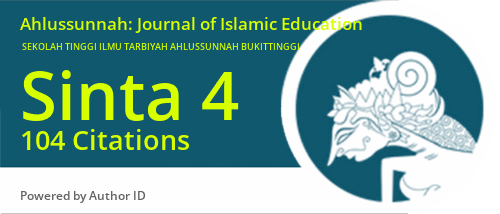Class Management in Islamic Cultural History Subject at Madrasah Tsanawiyah
DOI:
https://doi.org/10.58485/jie.v1i2.124Keywords:
Class management, history of Islam subjects, classroom strategiesAbstract
Class management is a determinant of creating a comfortable, conducive, and efficient learning atmosphere and learning objectives can be achieved. The aim of this research is to look at forms of classroom management that are conducive to history of Islam subjects at madrasah tsanawiyah muhammadiyah Padang Panjang. This research uses qualitative descriptive methods and the technique of purposive sampling. To obtain data, researchers used observation, interviews, and documentation. The data processing techniques are data reduction, data presentation, conclusions, or verification. Researchers use these data processing techniques to obtain accurate research results. The research results obtained are; i) class management requires a warm and enthusiastic teacher attitude, creating challenges in the learning process so that students become enthusiastic, having the ability to vary and be flexible in teaching so that students are active and try to focus during the learning process, emphasizing positive things and cultivating self-discipline so that the learning process is not disturbed and students have a sense of responsibility. ii) skills in preventive classroom management in the form of: a). being responsive and paying attention can prevent disturbances from students, b). providing clear instructions can help students stay focused in the learning process. Then classroom management skills are repressive in the form of a) modifying behavior, which can make students quickly and easily understand the material because they do not commit deviant actions during the learning process, b) finding and solving problematic behavior, which can make the learning process comfortable, effective, conducive and efficient. iii) supporting factors for classroom management such as curriculum, buildings, and teachers. Inhibiting factors such as facilities and infrastructure, as well as students and families in classroom management, can be a reference in improving or reducing the atmosphere of the learning process. The results of this research can be used as initial data for future researchers in studying this problem in different contexts and issues.
Downloads
References
Adnot, M., Dee, T., Katz, V., & Wyckoff, J. (2017). Teacher Turnover, Teacher Quality, and Student Achievement in DCPS. Educational Evaluation and Policy Analysis, 39(1), 54–76. https://doi.org/10.3102/0162373716663646
Aprilia, A., & Aminatun, D. (2022). Investigating Memory Loss: How Depression Affects Students’ Memory Endurance. Journal of English Language Teaching and Learning, 3(1), 1–11. https://doi.org/10.33365/jeltl.v3i1.1719
Arifin, I., Juharyanto, Mustiningsih, & Taufiq, A. (2018). Islamic Crash Course as a Leadership Strategy of School Principals in Strengthening School Organizational Culture. SAGE Open, 8(3). https://doi.org/10.1177/2158244018799849
Bandur, A. (2012). School-based management developments: Challenges and impacts. Journal of Educational Administration, 50(6), 845–873. https://doi.org/10.1108/09578231211264711
Bernadtua, M. S., Steven, M. L., & Seminary, M. (2021). Analysis of Tangiang Ale Amanami (Our Father) Using the Techniques of Translation. Journal of Advanced English Studies, 4(2), 7823–7830. https://doi.org/http://dx.doi.org/10.47354/jaes.v4i2.117
Bradshaw, C., Atkinson, S., & Doody, O. (2017). Employing a Qualitative Description Approach in Health Care Research. Global Qualitative Nursing Research, 4. https://doi.org/10.1177/2333393617742282
Burhanuddin, B., Ramadan, D., Nursyda, F., Marianti, E., & Safitri, W. (2022). Teacher’s Strategies for Increasing Students’ Interest in Learning Moral Lessons. International Journal of Multidisciplinary Research of Higher Education, 5(3), 108–114. https://doi.org/10.24036/ijmurhica.v5i3.138
Colorafi, K. J., & Evans, B. (2016). Qualitative Descriptive Methods in Health Science Research. Health Environments Research and Design Journal, 9(4), 16–25. https://doi.org/10.1177/1937586715614171
Coman, C., Țîru, L. G., Meseșan-Schmitz, L., Stanciu, C., & Bularca, M. C. (2020). Online teaching and learning in higher education during the coronavirus pandemic: Students’ perspective. Sustainability (Switzerland), 12(24), 1–22. https://doi.org/10.3390/su122410367
Domínguez, A., Saenz-De-Navarrete, J., De-Marcos, L., Fernández-Sanz, L., Pagés, C., & Martínez-Herráiz, J. J. (2013). Gamifying learning experiences: Practical implications and outcomes. Computers and Education, 63, 380–392. https://doi.org/10.1016/j.compedu.2012.12.020
England, M. J., Liverman, C. T., Schultz, A. M., & Strawbridge, L. M. (2012). Epilepsy across the spectrum: Promoting health and understanding. A summary of the Institute of Medicine report. Epilepsy and Behavior, 25(2), 266–276. https://doi.org/10.1016/j.yebeh.2012.06.016
Gage, N. A., Scott, T., Hirn, R., & Macsuga-Gage, A. S. (2018). The relationship between teachers’ implementation of classroom management practices and student behavior in elementary school. Behavioral Disorders, 43(2), 302–315. https://doi.org/10.1177/0198742917714809
Hayes, S. C., Barnes-Holmes, D., & Wilson, K. G. (2012). Contextual behavioral science: Creating a science more adequate to the challenge of the human condition. Journal of Contextual Behavioral Science, 1(1–2), 1–16. https://doi.org/10.1016/j.jcbs.2012.09.004
Holzberger, D., Philipp, A., & Kunter, M. (2013). How teachers’ self-efficacy is related to instructional quality: A longitudinal analysis. Journal of Educational Psychology, 105(3), 774–786. https://doi.org/10.1037/a0032198
Kim, H., Sefcik, J. S., & Bradway, C. (2017). Characteristics of Qualitative Descriptive Studies: A Systematic Review. Research in Nursing and Health, 40(1), 23–42. https://doi.org/10.1002/nur.21768
Koedinger, K. R., Corbett, A. T., & Perfetti, C. (2012). The Knowledge-Learning-Instruction Framework: Bridging the Science-Practice Chasm to Enhance Robust Student Learning. Cognitive Science, 36(5), 757–798. https://doi.org/10.1111/j.1551-6709.2012.01245.x
König, J., Jäger-Biela, D. J., & Glutsch, N. (2020). Adapting to online teaching during COVID-19 school closure: teacher education and teacher competence effects among early career teachers in Germany. European Journal of Teacher Education, 43(4), 608–622. https://doi.org/10.1080/02619768.2020.1809650
Ladson-Billings, G. (2014). Culturally relevant pedagogy 2.0: A.k.a. The remix. Harvard Educational Review, 84(1), 74–84. https://doi.org/10.17763/haer.84.1.p2rj131485484751
Lewallen, T. C., Hunt, H., Potts-Datema, W., Zaza, S., & Giles, W. (2015). The Whole School, Whole Community, Whole Child Model: A New Approach for Improving Educational Attainment and Healthy Development for Students. Journal of School Health, 85(11), 729–739. https://doi.org/10.1111/josh.12310
Manstead, A. S. R. (2018). The psychology of social class: How socioeconomic status impacts thought, feelings, and behaviour. British Journal of Social Psychology, 57(2), 267–291. https://doi.org/10.1111/bjso.12251
Perkins, D. N., & Salomon, G. (2012). Knowledge to Go: A Motivational and Dispositional View of Transfer. Educational Psychologist, 47(3), 248–258. https://doi.org/10.1080/00461520.2012.693354
Shanahan, T., & Shanahan, C. (2012). What is disciplinary literacy and why does it matter? Topics in Language Disorders, 32(1), 7–18. https://doi.org/10.1097/TLD.0b013e318244557a
Shernoff, D. J., Ruzek, E. A., & Sinha, S. (2017). The influence of the high school classroom environment on learning as mediated by student engagement. School Psychology International, 38(2), 201–218. https://doi.org/10.1177/0143034316666413
Smith, B. H. (2013). School-based Character Education in the United States. Childhood Education, 89(6), 350–355. https://doi.org/10.1080/00094056.2013.850921
Smith, L. N. (2017). Cyclical learning rates for training neural networks. Proceedings - 2017 IEEE Winter Conference on Applications of Computer Vision, WACV 2017, 464–472. https://doi.org/10.1109/WACV.2017.58
Sousa, D. (2014). Validation in Qualitative Research: General Aspects and Specificities of the Descriptive Phenomenological Method. Qualitative Research in Psychology, 11(2), 211–227. https://doi.org/10.1080/14780887.2013.853855
Suhatman, S., Sari, M. R., Nagara, P., & Nasfi, N. (2020). Pengaruh Atribut Produk dan Promosi Terhadap Minat Beli Konsumen Kota Pariaman di Toko Online Shopee. Jurnal Bisnis, Manajemen, Dan Ekonomi, 1(2), 26–41. https://doi.org/10.47747/jbme.v1i2.81
Sumani, S., Lian, B., & Fitriani, Y. (2020). Teacher’S Strategies To Protect Misbehavior of Students. International Journal of Educational Review, 2(2), 203–211. https://doi.org/10.33369/ijer.v2i2.10994
Ullsperger, M., Danielmeier, C., & Jocham, G. (2014). Neurophysiology of performance monitoring and adaptive behavior. Physiological Reviews, 94(1), 35–79. https://doi.org/10.1152/physrev.00041.2012
Waizenegger, L., McKenna, B., Cai, W., & Bendz, T. (2020). An affordance perspective of team collaboration and enforced working from home during COVID-19. European Journal of Information Systems, 29(4), 429–442. https://doi.org/10.1080/0960085X.2020.1800417
Willis, D. G., Sullivan-Bolyai, S., Knafl, K., & Cohen, M. Z. (2016). Distinguishing Features and Similarities Between Descriptive Phenomenological and Qualitative Description Research. Western Journal of Nursing Research, 38(9), 1185–1204. https://doi.org/10.1177/0193945916645499
Zalnur, M., Usral, Z., Rustiya, R., & Safarudin, R. (2022). Motivation and Forms of Student Activities in Religious Organizations. International Journal of Multidisciplinary Research of Higher Education, 5(4), 138–144. https://doi.org/10.24036/ijmurhica.v5i4.145
Downloads
Published
How to Cite
Issue
Section
License
Copyright (c) 2022 Thulus G. Syahbana, Elvi Rahmi, Anita Indria, Yunus Rahawarin, Maradona Maradona

This work is licensed under a Creative Commons Attribution-ShareAlike 4.0 International License.
Creative Commons Attribution 4.0 (CC BY)











